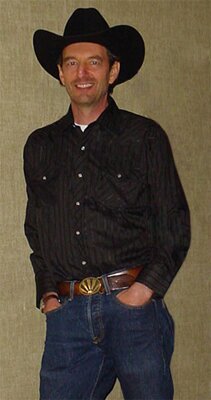Welcome to the “My Place” page
 My name is Scott My name is Scott
I run the Rope and Wire website.
My original idea for this page was to give those living in the country the opportunity to tell others about the things that made their farm or ranch so special.
Well, I’ve come to the conclusion that either no one likes to brag or no one lives on a farm or a ranch. Whatever the case, no one submitted an article so I felt it was high time to try something different.
So for now this will be literally “My Place.” I’ll use this page to post a western blog or short articles. They will either be mine, or possibly one from a contributing R&W community member.
The theme will remain Western but the content will change weekly, or there about.
If you click on any of the links to past blog's, you can return to this page by clicking on the My Place button across from my picture.
I hope you enjoy it but if not, might I suggest you “stroll the grounds.” Read a story or watch a movie.
Thanks for visiting.
Scott
Our American Heritage
As the family farm slowly disappears from the American landscape, so goes one of our most essential and powerful symbols of independence, hard work and tradition.
A once vital center for community life, and as some would see it, the very heart of our American landscape. An iconic fixture from coast to coast if there ever was one.
What, you might ask, is so slowly disappearing before our very eyes that we hardly notice it’s passing. I’m speaking of no less than an American symbol, simply put…our countries barns.
Their massive timbers pinned in place and built to last a hundred years or more. Built by hand, by communities of neighbors volunteering their time and talents for the common good of friends and fellow farmers.
Although there may be many different styles of barns including Dutch, Bank, Crib, Round and Prairie to name a few, most served a common purpose. They were the great storehouses for generations of farming equipment and supplies. Grain was threshed on barn floors during the harvest season and stored in massive silos. Great lofts held tons of hay and straw for the feeding and bedding of livestock during the winter months, while stalls on the main floor offered a farmers stock a degree of shelter from the elements.
The unfortunate thing for barns, and one of the reasons for their ultimate demise is that our modern agricultural equipment has gotten so massive, it no longer fits through their doors. Another factor is that old barn wood has become the wood of choice in newer upscale construction. Exposed massive old growth beams and finished barn-wood flooring are in vogue. Never mind the fact that a greedy, uncaring few are tearing down our heritage… there’s money to be made.
In this part of the country I see my fair share of dilapidated and outright abandoned barns. They are dying a slow death as they succumb to the elements and I find it difficult to watch. It’s a shame if not a crime. As far as I’m concerned, if you own it, you should maintain it.
The Prairie, or Western barn is the one I remember from my youth. On average, it is much larger than most other barns, with a much larger loft for storing hay and feed.
I was one of six kids born in the big city of St. Paul, Minn. But I was fortunate enough to have an uncle who happened to own a large farm not too far away, near Grand Forks, North Dakota. Each summer, for one weekend, my parents would pack us kids into an old ford station wagon and drive out to the country, to my uncle’s place. While my parents had a good visit with family, us kids and cousins had a great time playing in and around their big old barn, chasing chickens and being chased by huge pigs. (The ladder to the loft was in the pigpen). It was a risk, and great fun as well, to see if we could get to the ladder before the “Big” pig got to us. But building a hay fort in the loft was well worth the risk, and lucky for us, we always made it. We eventually moved to Oregon and I’ve missed that old barn ever since.
Just the smell of an old barn brings back some great memories and I must admit, I do feel a sense of loss whenever I see one of these great American icons, swaybacked and pitched to the point of no return. But, then I know all is not lost. There are organizations out there that believe it to be a worthy cause to save these bits of American history. Many a good barn has been brought back from the brink of extinction by the passion, dedication and hard work of those who care enough to roll up their sleeves and do something about it by either raising money or repairing a roof. I’m grateful for those who care.
|